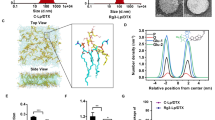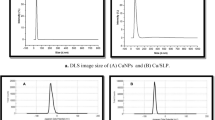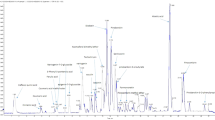ABSTRACT
Purpose
We have demonstrated that (-)-gossypol-enriched cottonseed oil [(-)-GPCSO] can down-regulate Bcl-2 expression in MCF-7 and primary cultured human breast cancer epithelial cells (PCHBCECs). However, this agent has not been evaluated in vivo due to its limited solubility. We aimed to develop liposomes containing (-)-GPCSO to suppress Bcl-2/Bcl-xL expression.
Methods
(-)-GPCSO liposomes were prepared and evaluated for effects on breast cancer cell viability, MDA-MB-231 xenograft tumor growth, cellular Bcl-2 and Bcl-xL mRNA levels, and chemosensitivity to paclitaxel.
Results
(-)-GPCSO liposomes prepared had excellent stability. Cytotoxicity of (-)-GPCSO liposomes was significantly reduced compared to (-)-GPCSO in culture medium. Bcl-2 and Bcl-xL mRNA expression was down-regulated by (-)-GPCSO in culture medium or (-)-GPCSO liposomes in MDA-MB-231 cells. In PCHBCECs, Bcl-2 and Bcl-xL expression were down-regulated by (-)-GPCSO liposomes. (-)-GPCSO in culture medium induced only a mild reduction in Bcl-xL. In the MDA-MB-231 xenograft tumor model, (-)-GPCSO liposomes exhibited tumor-suppressive activity and significantly reduced intratumoral Bcl-2 and Bcl-xL expression. Cytotoxicity of paclitaxel was increased by pretreatment with (-)-GPCSO liposomes in MDA-MB-231 and PCHBCECs.
Conclusions
Findings suggest that (-)-GPCSO liposomes warrant continued investigation as a chemosensitizer for breast cancers exhibiting Bcl-2-/Bcl-xL-mediated drug resistance.





Similar content being viewed by others
REFERENCES
Jemal A, Siegel R, Ward E, Murry T, Xu J, Smigal C, et al. Cancer statistics. CA Cancer J Clin. 2006;56:106–30.
Smigal C, Jemal A, Ward E, Collinides V, Smith R. Trends in breast cancer by race and ethnicity. CA Cancer J Clin. 2006;56:168–83.
Coley HM. Mechanisms and strategies to overcome chemotherapy resistance in metastatic breast cancer. Cancer Treat Rev. 2008;34:378–90.
LaPensee EW, Ben-Jonathan N. Novel roles of prolactin and estrogens in breast cancer: resistance to chemotherapy. Endocr Relat Cancer. 2010;17:R91–107.
Emi M, Kim R, Tanabe K, Uchida Y, Toge T. Targeted therapy against Bcl-2-related proteins in breast cancer cells. Breast Cancer Res. 2005;7:R940–52.
Moulder SL, Symmans WF, Booser DJ, Madden TL, Lipsanen C, Yuan L, et al. Phase I/II study of G3139 (Bcl-2 antisense oligonucleotide) in combination with doxorubicin and docetaxel in breast cancer. Clin Cancer Res. 2008;14:7909–16.
Tuszynski GP, Cossu G. Differential cytotoxic effect of gossypol on human melanoma, colon carcinoma, and other tissue culture cell lines. Cancer Res. 1984;44:768–71.
Rao PN, Wang YC, Lotzova E, Khan AA, Rao SP, Stephens LC. Antitumor effects of gossypol on murine tumors. Cancer Chemother Pharmacol. 1985;15:20–5.
Majumdar SK, Daly EP, Kleemeyer KM, Daehler CC, Baker MA. Genotoxic effects of gossypol acetic acid on cultured murine erythroleukemia cells. Environ Mol Mutagen. 1991;18:212–9.
Gilbert NE, O’Reilly JE, Chang CJ, Lin YC, Brueggemeier RW. Antiproliferative activity of gossypol and gossypolone on human breast cancer cells. Life Sci. 1995;57:61–7.
Wang X, Wang J, Wong SC, Chow LS, Nicholls JM, Wong YC, et al. Cytotoxic effect of gossypol on colon carcinoma cells. Life Sci. 2000;67:2663–71.
Benz CC, Keniry MA, Ford JM, Townsend AJ, Cox FW, Palayoor S, et al. Biochemical correlates of the antitumor and antimitochondrial properties of gossypol enantiomers. Mol Pharmacol. 1990;37:840–7.
Shelley MD, Hartley L, Fish RG, Groundwater P, Morgan JJ, Mort D, et al. Stereo-specific cytotoxic effects of gossypol enantiomers and gossypolone in tumour cell lines. Cancer Lett. 1999;135:171–80.
Liu S, Kulp SK, Sugimoto Y, Jiang J, Chang HL, Dowd MK, et al. The (-)-enantiomer of gossypol possesses higher anticancer potency than racemic gossypol in human breast cancer. Anticancer Res. 2002;22:33–8.
Ye W, Chang HL, Wang LS, Huang YW, Shu S, Sugimoto Y, et al. Induction of apoptosis by (-)-gossypol-enriched cottonseed oil in human breast cancer cells. Int J Mol Med. 2010;26:113–9.
Safra T, Muggia F, Jeffers S, Tsao-Wei DD, Groshen S, Lyass O, et al. Pegylated liposomal doxorubicin (Doxil): reduced clinical cardiotoxicity in patients reaching or exceeding cumulative doses of 500 mg/m2. Ann Oncol. 2000;11:1029–33.
Gibbs WJ, Drew RH, Perfect JR. Liposomal amphotericin B: clinical experience and perspectives. Expert Rev Anti-infective Ther. 2005;3:167–81.
Sharma A, Mayhew E, Straubinger RMA. Antitumor effect of paclitaxel-containing liposomes in a paclitaxel-resistant murine tumor model. Cancer Res. 1993;53:5877–81.
Boehlke L, Winter JN. Sphingomyelin/cholesterol liposomal vincristine: a new formulation for an old drug. Expert Opin Biol Ther. 2006;6:409–15.
Medina OP, Zhu Y, Kairemo K. Targeted liposomal drug delivery in cancer. Curr Pharm Des. 2004;10:2981–9.
Cui Y, Wu Z, Liu X, Ni R, Zhu X, Ma L, et al. Preparation, safety, pharmacokinetics, and pharmacodynamics of liposomes containing Brucea javanica oil. AAPS PharmSciTech. 2010;11:878–84.
Pan XQ, Zheng X, Shi G, Wang H, Ratnam M, Lee RJ. Strategy for the treatment of acute myelogenous leukemia based on folate receptor beta-targeted liposomal doxorubicin combined with receptor induction using all-trans retinoic acid. Blood. 2002;100:594–602.
Zhai G, Wu J, Zhao X, Yu B, Li H, Lu Y, et al. A liposomal delivery vehicle for the anticancer agent gossypol. Anticancer Res. 2008;28:2801–5.
Yang X, Koh CG, Liu S, Pan X, Santhanam R, Yu B, et al. Transferrin receptor-targeted lipid nanoparticles for delivery of an antisense oligodeoxyribonucleotide against Bcl-2. Mol Pharm. 2009;6:221–30.
Johnstone RW, Ruefli AA, Lowe SW. Apoptosis: a link between cancer genetics and chemotherapy. Cell. 2002;108:153–64.
Shangary S, Johnson DE. Recent advances in the development of anticancer agents targeting cell death inhibitors in the Bcl-2 protein family. Leukemia. 2003;17:1470–81.
Kirkin V, Joos S, Zornig M. The role of Bcl-2 family members in tumorigenesis. Biochim Biophys Acta. 2004;1644:229–49.
Elenbaas B, Spirio L, Koerner F, Fleming MD, Zimonjic DB, Donaher JL, et al. Human breast cancer cells generated by oncogenic transformation of primary mammary epithelial cells. Genes Dev. 2001;15:50–65.
Hiraoka N, Ino Y, Sekine S, Tsuda H, Shimada K, Kosuge T, et al. Tumour necrosis is a postoperative prognostic marker for pancreatic cancer patients with a high interobserver reproducibility in histological evaluation. Br J Cancer. 2010;103:1057–65.
Chen N, Chen X, Huang R, Zeng H, Gong J, Meng W, et al. BCL-xL is a target gene regulated by hypoxia-inducible factor-1{alpha}. J Biol Chem. 2009;284:10004–12.
ACKNOWLEDGMENTS & DISCLOSURES
This study is supported by NIH Grant R01 ES-015212 and Cotton Inc. Grant 06–864.
Author information
Authors and Affiliations
Corresponding authors
Rights and permissions
About this article
Cite this article
Li, H., Piao, L., Xu, P. et al. Liposomes Containing (-)-Gossypol-Enriched Cottonseed Oil Suppress Bcl-2 and Bcl-xL Expression in Breast Cancer Cells. Pharm Res 28, 3256–3264 (2011). https://doi.org/10.1007/s11095-011-0498-2
Received:
Accepted:
Published:
Issue Date:
DOI: https://doi.org/10.1007/s11095-011-0498-2




